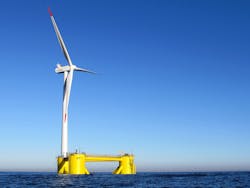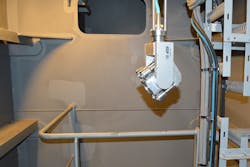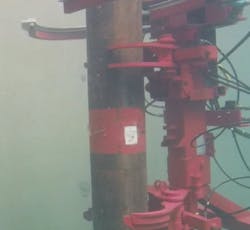Floating offshore wind presents opportunities, challenges
Some of the planned floating offshore wind (FOW) turbines will be as high as the Eiffel Tower, so stability and safe mooring will be a challenge. This is relatively straightforward on land, but it is a greater challenge in deepwater with the relative motions and loads of a floating structure and the rotating generation system.
At this stage of a pioneering industry, many different designs are being put forward. It will take some time before the most efficient and economic designs make their way to the front. Various pilot projects are under way, and the industry will learn a lot in the next few years as the results are known.
A few features will likely be common to most of the designs. For example, they will all have mooring systems and some form of structure to support the mast and generating system.
Furthermore, stakeholders such as financiers, regulators, certification/classification societies, insurers, and the coastal states in which FOW farms are located will all want assurance of the reliability, efficiency, and safety of their investments.
New inspection and maintenance methods will need to be developed to keep these massive floating assets ‘fit for purpose’ throughout their operational life. Also, it would be wise to plan for life extension and eventual decommissioning in a safe and environmentally friendly manner. Recycling composite materials is not easy, and may not be economically viable, so this will be another challenge for the future.
Intermittency is a problem for most renewable systems, as they all struggle to guarantee 24/7 power, so floating wind will also need to address this issue. Green hydrogen may be part of the answer. There is plenty of water around floating wind turbines, so electrolysers could be used to provide hydrogen for storage and use in alternative generators when required for back-up power.
Other designs incorporate wave energy to reduce the intermittency and other renewable and possibly fossil fuel backup systems will evolve as the industry learns more.
Many of the robotic and digital asset integrity management technologies developed for other floaters such as FPSOs, FLNGs, FRSUs, drillships, and semisubmersibles could be adapted to cope with floating wind assets.
For the last eight years, EM&I has led a joint industry project (JIP) on behalf of the Global FPSO Research Forum, which includes classification societies, service providers, vessel operators, and oil majors. Many of the companies are increasingly involved in the floating wind sector and are looking at the methods developed for FPSOs as a guide to what might be transferable technology for FOW turbines.
As floating wind assets are not normally manned, autonomous supply vessels and robotic methods of inspection including ‘resident robots’ will become the new norm, as will methods of monitoring condition on a risk or sampling basis because of the repetitive nature of the designs in a particular farm.
Cost will be an important factor in whatever assurance methods are adopted for the FOW business model.
Classification societies will generally opt for remote inspections in the future, so operators will have to adapt to this way of working. Satellite surveillance, drones, and mooring system monitoring will check the positions of floating wind turbines to ensure that their moorings are secure and not at risk of damaging their own or neighboring anchor systems.
JIPs are probably one of the best ways to develop the new technologies rapidly as all the main stakeholders are involved to identify challenges, encourage solutions, and help bring them to the industry as proven improvements.
EM&I has set up JIPs for ‘FloWind’ and ‘FloGas’ to help develop asset integrity management solutions for these sectors. Leading the Hull Inspection Techniques & Strategy (HITS) JIP for the Global FPSO Research Forum has provided experience in understanding how to get good results from the investment that the members make.
While HITS is focused on FPSOs, the FloGas JIP is aimed at what the company believes is a transitional energy source between oil and renewables such as FOW. The intent of the FloWind JIP is to gather representatives from all sectors of the FOW industry, identify asset integrity challenges, and encourage the development of solutions.
Some unexpected technologies were developed in the HITS JIP. For example, diverless inspections, cleaning, valve and hull repairs, corrosion protection systems, and remote inspections of confined spaces using cameras and lasers.
The JIP stakeholders decide on the requirements and performance parameters, monitor progress, and observe demonstrations before giving guidance on how best to use the innovations. Pilot projects are often done to iron out any practical issues.
This has worked well as the innovations are more easily accepted when accepted by the JIP, which includes many distinguished energy industry experts in the supermajors, classification societies, academic and research organizations.
Some innovative asset integrity methods that may be applicable to the FOW sector are described below.
The ODIN diverless UWILD technology for hull, valves and sea chest inspection and repair, and NoMan remote camera and laser scanning technologies are classic examples. The company often ‘fast-tracks’ new technologies by studying other industries to see if they have solved similar problems, and then adapt these well-proven technologies for the energy industries.
EM&I has adapted technologies from the aerospace, nuclear, civil engineering, medical and forestry industries.
The NoMan technology was derived from the nuclear industry and uses cameras which can pan, tilt, and zoom, and are Ex rated, so it can be used in most environments. The synchronous laser scanning can also detect corrosion, coating breakdown, pitting, and deflection.
The LORIS technology was derived from the forestry industry and can clean, measure, and climb up or down mooring chains.
Floating wind is one of the most exciting renewable energy sectors as wind speeds are much stronger in deepwater. Plus, it does not interfere with coastal fishing, which is usually in shallow water, or damage the seabed which is becoming a significant environmental concern.
If we can overcome the technical challenges in the stability, mooring, operation and maintenance of these massive assets, we will be able to provide renewable energy for decades to come.


